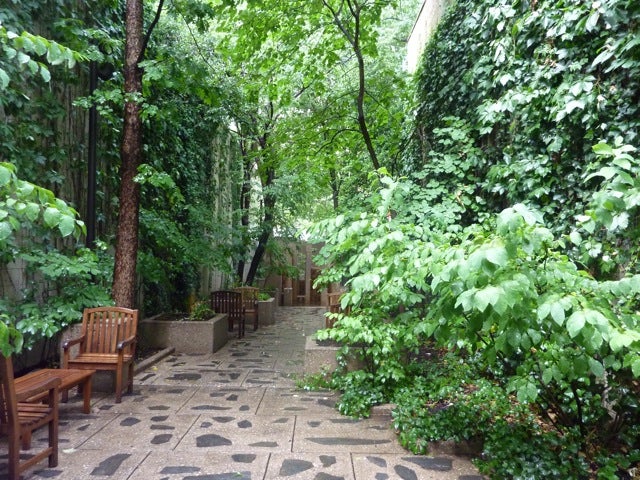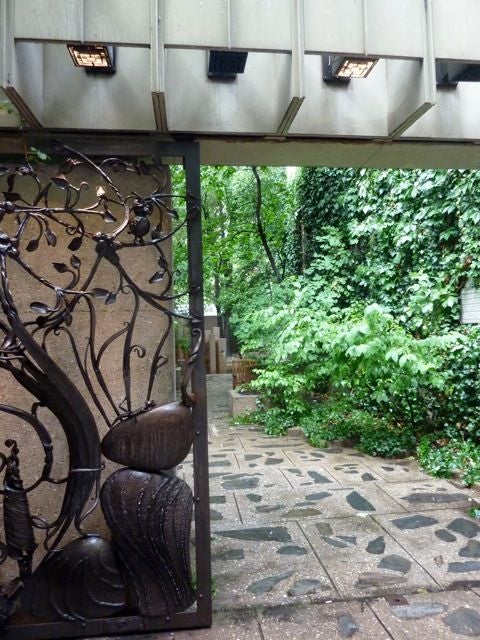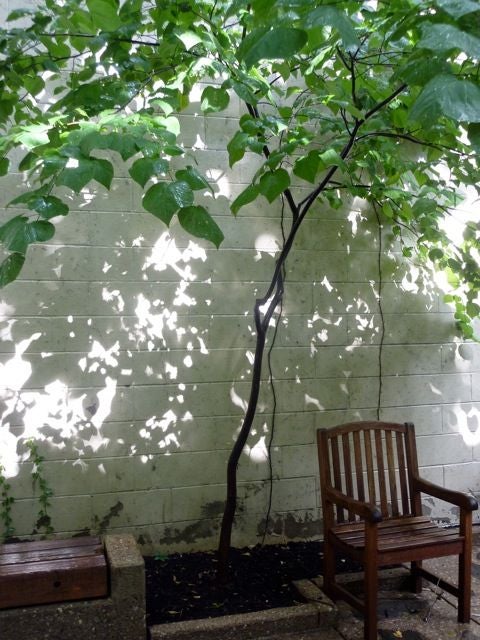TLC for a unique Center City “pocket park”
There’s a tiny park in the middle of Center City that’s been showered with honors, that features ivy-covered walls and moveable furniture, and that comes equipped with its very own water feature.
Many people, especially office workers, love it — yet it remains largely undiscovered.
Thanks to a $300,000 grant from the William Penn Foundation, the Center City District plans on changing that. Starting this September, it will take the assets that the modestly-named Chestnut Park shares with its much more famous brother, New York’s Paley Park, and shine a (literal) spotlight on them. In addition to a reworked lighting scheme, plans call for the repair of the park’s fountain, and for the relocation of its front gate.
The hope is to once again bring the park into the league of the one that inspired it.
When urbanist William H. Whyte conducted his famous time-lapse photography studies on the streets of New York City in the early 1970s, he celebrated the “girl watchers” and “schmoozers,” the street vendors and skilled pedestrians that gave organic life to city streets. But especially eye-opening was his analysis of why some contrived places like Paley Park (conceived of by William Paley, then chairman of CBS Broadcasting) were successful.
One who drew inspiration from the park, which opened in 1967, was our own local philanthropist, Dorothy (Mrs. F. Otto) Haas. Even before Whyte’s findings were made public, she thought Philadelphia deserved its own verdant jewel box.
And so, as a board member of the William Penn Foundation (founded on Haas money), she encouraged its development. Through alliances with the PennJerDel Council and the city’s Redevelopment Authority, a spot at 9th and Walnut was eventually located. That option fell through, and a narrow lot on the 1700 block of Chestnut Street was selected instead. In 1979, Chestnut Park was unveiled.
The park eventually won an award from the American Society of Landscape Architects, and garnered accolades in planning circles. Over the decades, however, it suffered periods of disinvestment. A few years ago, the CCD assumed its maintenance and stewardship, and gradually the trash and homeless encampments disappeared and the park enjoyed a rebirth. Last year, the organization replenished the park’s native plantings, and began examining lunchtime programming options.
While technically not a true pocket park — since it’s enclosed on only two sides — Chestnut Park “is very special because it’s Center City’s contemporary example of the idea,” says William Penn’s Shawn D. McCaney. “Now that it’s been stabilized through management by an organization specifically experienced in public space maintenance, we’re hoping that we can better promote it as a wonderful respite and a great example of design from the period.”
According to Nancy Goldenberg, vice president of planning at CCD, the renovation, which will be steered by Kieran Timberlake, should be completed by early December. “This will be an upgrade,” she says, “with us generally tweaking what needs to be fixed. But we will maintain the integrity and intent of the original design, which is so unique and important.”
Sandwiched rather ignominiously between two banal one-story buildings, the park was designed by John Collins, who founded Temple University’s Department of Landscape Design and had a hand in designing some of the city’s most beloved public spaces, from Society Hill’s Three Bears Park to the 40-years-in-the-making Schuylkill River Park.
Chestnut Park’s distinctive ornamental iron gates — wreathed with flora and fauna — were designed by metalsmith Christopher Ray. On the main gate, birds, insects and fish — in all, 13 critters — frolic in a whimsical re-creation of the Wissahickon Valley. There’s even a subversive homage to the region’s favorite delicacy — the hoagie — in one corner as a frog enjoys a bug sandwich.
The restoration calls for this gate to be moved forward, closer to the street line, so the park will be more readily noticeable. It’s an interesting decision, considering Whyte singled out Paley Park’s similar entrance — a transitional recessed area that brings forth design elements from the park onto the sidewalk — as a selling point that aroused the curiosity of passersby. At Chestnut Park, however, it’s very easy to swing by the space with nary a sidelong glance.
Thanks to its preponderance of aggregate concrete and its emphasis on shade and enclosure, Chestnut Park does seem very much of its time. Still, it never appears dated, and it manages to escape the bunker mentality that so dominated urban design of the era — especially when it’s crowded with weekday lunchtime workers.
Even on a recent rainy Saturday morning, as the tweetings of birds muffled the sounds of a stray horn or two, the space’s lush confines felt wondrous. When in leaf, towering trees provide a canopy of green within two quite high cinder block walls, while low beds of native shrubs and groundcovers like oakleaf hydrangea, ferns, and pachysandra fill in a composition that relies solely on itself. There’s almost no borrowed landscape views to be found.
At the center of it all lies the fountain — several concrete monoliths, arranged as if to suggest a city skyline, sitting in a sunken plaza three steps down. Sculpted frogs and birds have alighted at various points: they were crafted by Collins’ then-young children and nephews.
It will seem all the more charming once the pumping and draining systems are repaired — the presence of running water should alleviate the hardscaping’s more brutal traits, and enhance the woodland effects.
As will the reworked lighting, to be handled by The Lighting Practice, the Philadelphia design firm responsible for lighting projects in Aviator Park in front of the Franklin Institute, on the Benjamin Franklin Parkway and Avenue of the Arts, and at Eastern State Penitentiary. (The firm garnered national headlines, too, when it was selected to redesign lighting of the U.S. Capitol dome.)
The current lighting, pole-mounted in the corners of the park, is a tad harsh and ill-distributed, says Al Borden, a principle at TLP. “Our idea is to use a warmer source and to mount smaller, shielded fixtures in the tallest trees — about 25-feet high — so it will look like light is coming from the sky and casting leaf patterns,” he says. “You’ll feel like you’re in a gently-lit garden.”
Although the park’s total “foot candles” will only be slightly higher, more careful illumination of its pathways should provide greater drama — as well as increased safety, Borden continues. “Lighting is always important in a public space,” he says, “but it becomes even more so in a tiny park. After it fulfills the basic functions of security, it becomes a true amenity. In this case, even when the park is closed, it will be lit and able to be viewed from the street as a piece of art.”
Currently, the park closes at 6:30 p.m., but CCD is considering ways to activate the space so it can stay open later. “It’s a delicate balance of keeping the air of peace and quiet that people really love, and extending the use of the park,” says Goldenberg.
Contact JoAnn Greco at www.joanngreco.com
Check out her new online magazine, TheCityTraveler at www.thecitytraveler.com
WHYY is your source for fact-based, in-depth journalism and information. As a nonprofit organization, we rely on financial support from readers like you. Please give today.










